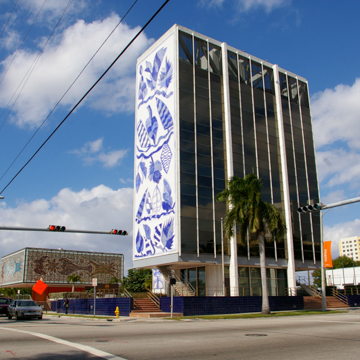The construction of the Bacardi Building, Miami’s first significant International Style office tower, marked an important turning point for both the client and the city. The elegant building was designed for the Bacardi Rum Corporation by Enrique Gutiérrez as part of the company’s efforts to transform its public image and corporate culture after having to leave Cuba following the 1959 Revolution. Built on a prominent site on Biscayne Boulevard, it also marked Miami’s emerging status as a hub for international business, as civic leaders pursued a goal of establishing Miami as the commercial center of the Americas.
The Bacardi tower was one of a number of prominent modernist buildings commissioned by the company in the 1950s and 1960s as it employed architecture as part of a rebranding strategy aimed at presenting the company as a progressive and sophisticated enterprise with global reach. Led by Pepin Bosch, a politically active executive with a strong interest in the visual arts and architecture, Bacardi’s patronage included elegant designs for crystalline office buildings by Ludwig Mies van der Rohe in Santiago de Cuba and Tultitlán, Mexico. Mies had just completed the iconic headquarters of Bacardi’s competitor, the Seagram Company, in New York City. The Santiago project remained unrealized as a result of the Cuban Revolution (though its combination of overhanging canopy roof, glazed walls, and pedestal-like plinth would strongly influence Mies’s design of the New National Gallery in Berlin), while the Tultitlán building was completed in 1962. The Tultitlán office building was soon joined by a sinuously vaulted bottling plant and other structures designed by Felix Candela.
A recurring theme of lightness ripples throughout the design of the Bacardi Building. The tower hovers over a plinth, with its office floors suspended from two deep trusses that sit atop four slender, marble-clad piers. Most of the building’s volume cantilevers beyond the piers, which, in concert with its blue-tinged glass curtain wall, produces an effect of weightlessness when seen from Biscayne Boulevard. Gutiérrez reinforced the floating quality of the building by recessing the lobby and glazing it in clear glass, as if it was left behind when the rest of the tower began to levitate. Two exterior fire stairs dangle from the underside of the second floor, hovering above the plinth like the stairs of a 707, further emphasizing the delicate sense of elevation.
The floating quality of the tower owes much to the work of Gutiérrez’s mentor, Mies van der Rohe, with whom Gutiérrez worked on the design for the Bacardi office building in Santiago de Cuba. A similar sense of lightness pervades both projects. Yet while the Miami tower lacks the refinement of detail in the projects Mies designed for Bacardi, it adds elements that Mies eschewed in his contemporary work: polychromy and decoration.
The end walls of the tower are clad in enormous azulejo murals by Recife-based artist Francisco Brennand. Painted by hand in Brazil, the blue and white tiles depict tropical vegetation. The incorporation of a transnational artistic medium with roots in Iberia and Latin America reflects the company’s international orientation, both in terms of supply chain and markets. The integration of the decorative arts in a corporate office building, an increasingly common motif of postwar American architecture, illustrated Bacardi’s longstanding patronage of the visual arts and crafts. The company also commissioned murals depicting themes related to spirits production and consumption in the penthouse boardroom and executive offices by Alberto Fernando Pla.
This theme was also expressed in the great stained glass windows that form all four walls of the annex. Built in 1974 to the designs of architect Ignacio Cabrera-Justiz, the annex housed the company’s secretarial pool in a two-story volume suspended above the shared plinth by the tile-clad circulation core. The two floors are imperceptible behind the massive glass murals by German artist Johannes Dietz, which use the same design for their mullions (an abstraction of Bacardi’s vespertilionine corporate logo), but in different color combinations. Dietz’s murals, fabricated from thick pieces of glass shaped roughly with a hammer, produce a stunning effect when backlit at night.
The Bacardi Building now houses the national headquarters for the National YoungArts Foundation, which is renovating the existing structures and constructing a new building to create a campus for the organization. The masterplan is being designed by Frank Gehry, who, along with Plácido Domingo and Bill T. Jones, serves as an artistic advisor to the organization.
References
O’Rourke, Kathryn E. “Mies and Bacardi: Mixing Modernism, c. 1960.” Journal of Architectural Education66, no. 1 (October 2012): 57-71.
Read, Gray. “The Bacardi Building.” In Miami Modern Metropolis: Paradise and Paradox in Midcentury Architecture and Planning, edited by Allan T. Shulman, 178-183. Miami, FL: Bass Museum of Art, 2009.
Shulman, Allan T., Randall C. Robinson, and James F. Donnelly. Miami Architecture: An AIA Guide Featuring Downtown, the Beaches, and Coconut Grove. Gainesville: University Press of Florida, 2010.

